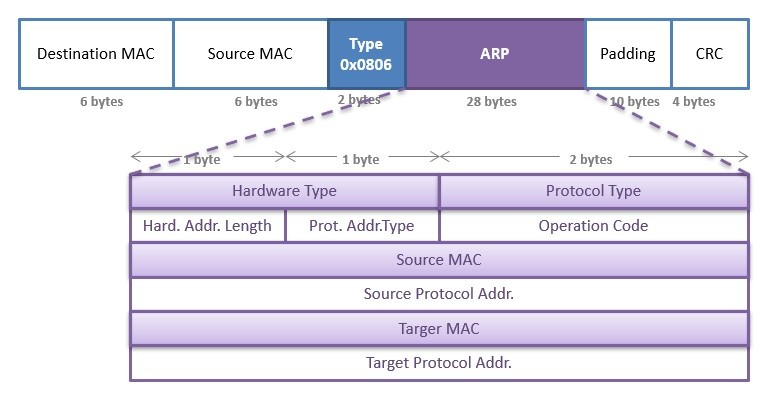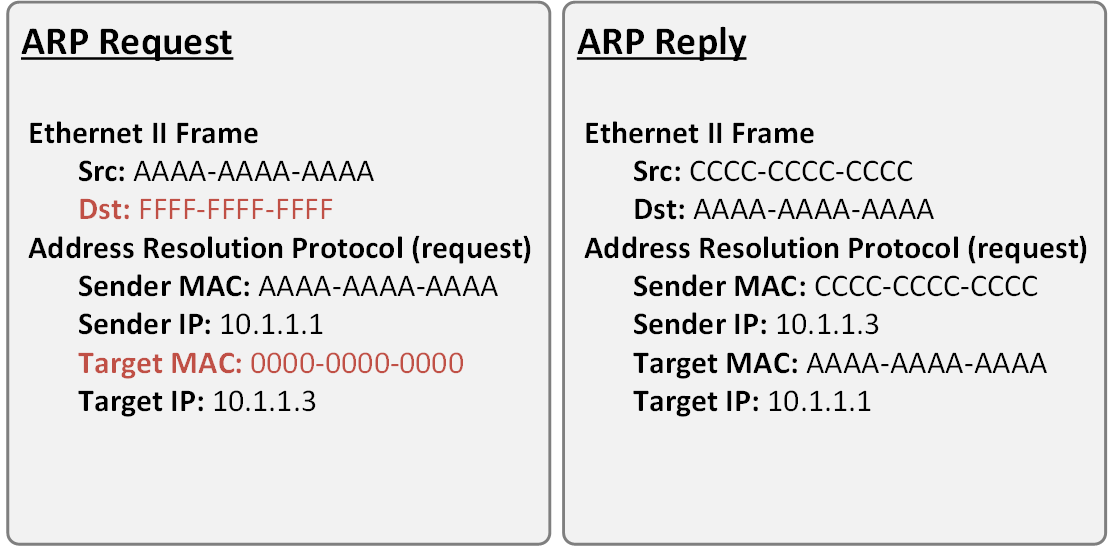It is used to find layer 3 address from layer 2 address like DLCI in frame relay. Pinging involves sending an ICMP echo request to the target host and waiting for an ICMP echo reply.

A Unicast Arp Request Networking Tales
--destaddr or -T Send the packets to Ethernet MAC address This sets the 48-bit destination address in the Ethernet frame header.

. The ARP process sends a Layer 2 broadcast to all. The router will respond with the MAC address of its interface the one which is connected to the same network as the. It will send an ARP request to the DNS server for the destination MAC address.
MAC Address Tables. Note that the ARP Reply has the Opcodef filled as 2 which is used to identify it as a ARP Reply. When sending a packet to a remote destination a host will need to send the packet to a gateway on the local subnet.
Reverse ARP RARP - It is a networking protocol used by the client system in a local area network LAN to request its IPv4 address from the ARP gateway router table. In order to find out the MAC address of host B host A sends an ARP request listing the host Bs IP address as the destination IP address and the MAC address of FFFFFFFFFFFF Ethernet broadcast. The majority of the time this will be Ethernet which will also be the L2 medium we will be looking at in our examples.
The used MAC address for the reply can be specified. Most operating systems will also respond if the ARP request is sent to their MAC address or to a multicast address that they are listening on. The ARP request packet is then encapsulated in an Ethernet frame with the MAC address of Host A as the source address and a broadcast FFFFFFFFFFFF as the destination address.
The protocol must be specified as ARP. ARP Reply will be a unicast to save Network Resources. The program reports errors packet loss and a statistical summary of the results typically including the minimum maximum the mean round-trip times and standard deviation of the mean.
Which destination address is used in an ARP request frame. Switch will forward the frame out all interfaces except the incoming interface. The default is the broadcast address ffffffffffff.
When using Nmap on a local network ARP protocol is applied by default for being faster and more reliable. The source device will not know the MAC address of the remote host. 0000 255255255255 FFFFFFFFFFFF AAAAAAAAAAAA the physical address of the destination host Answers Explanation Hints.
The gateway address must be configured on each host. When using inverse ARP we know the DLCI or remote router but dont know its IP address. When the computer with the IP Address 1921680122 receives the ARP Request it must prepare an ARP Reply and send back to the computer who sent the ARP Request.
The ARP Request is an ARP payload carried within the appropriate L2 frame for the medium in use. When the destination device lies on a remote network one beyond another Layer 3 device the process is the same except that the sending device sends an ARP request for the MAC address of the default gateway. Each device on the segment will receive the packet but.
The purpose of an ARP request is to find the MAC address of the destination host on an Ethernet LAN. If this target sees an ARP request it will automatically reply with an ARP reply. When a frame is sent to a device not on the local network the gateways MAC address is used in the frame header.
When the ARP message is not an ARP request or when the ARP request isnt for an IP address on an Ethernet network it is ignored by this target CONTINUE. It dynamically maps local DHCP or remote IP addresses when you configure frame relay. Nping allows to generate packet under many protocols as it official website describes it can also be used for ARP poisoning Denial of.
An ARP request will be sent by the source and will be responded to by the router. Now lets break this down a little bit to understand how the MAC address table is built and used by an Ethernet switch to help traffic move along the path to its destination. After the address is resolved and the default gateway receives the packet the default gateway broadcasts the destination IP address over the.
Since the ARP request is a broadcast it reaches all the nodes in the Subnet A which includes the e0 interface of the router but does not reach Host D. ARP Address Resolution Protocol is a low level protocol working at Link layer level of the Internet Model or Internet protocol suite. This tutorial lesson explains ethernet frame format structure of ethernet frame ethernet frame header fields preamble sfd start frame delimiter source and destination MAC Address length datapadding and FCS Frame Check Sequence Ethernet runt and giant Frames.
The ARP request packet is then encapsulated in an Ethernet frame with the MAC address of Host A as the source address and a broadcast FFFFFFFFFFFF as the destination address. The Address Resolution Protocol uses a simple message format containing one address resolution request or response. A table is created by the network administrator in the gateway-router that is used to find out the MAC address to the corresponding IP address.
The size of the ARP message depends on the upper layer and lower layer address sizes which are given by the type of networking protocol usually IPv4 in use and the type of hardware or virtual link layer that the upper layer protocol is. --arpsha or -u Use. Because the gateway will be the Layer 2 destination for the frame on this LAN segment the destination MAC address must be the address of.
The network host IP interface binds the gateway address to the MAC address of the physical gateway by broadcasting IP datagrams and caching the MAC address of the reply from the gateway in an. A Destination MAC address a Source MAC address and an EtherType. The Ethernet header will include three fields.
A frame is encapsulated with source and destination MAC addresses. The command-line options of the ping utility and its output vary between the numerous. A MAC address table sometimes called a Content Addressable Memory CAM table is used on Ethernet switches to determine where to forward traffic on a LAN.
Layer 2 broadcast means that frame will be sent to all hosts in the same layer 2 broadcast domain which includes the ether0 interface of the router but does not reach Host D.

Arp Protocol Overview What Is Arp Arp Process Ipcisco

Arp Fundamentals Netengine 8000 X V800r012c00spc300 Feature Description Ip Services 04 Huawei

0 Comments